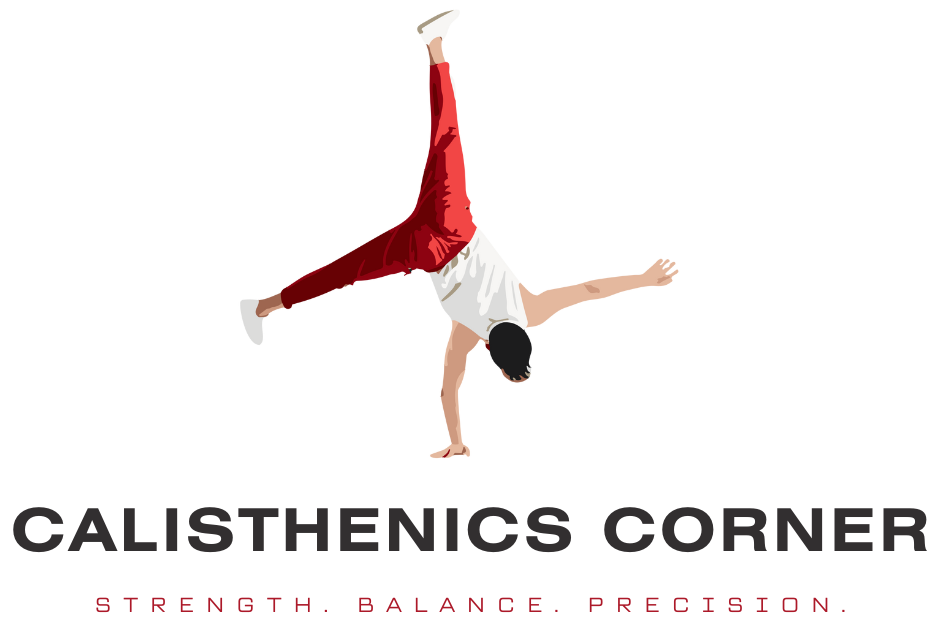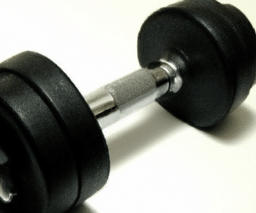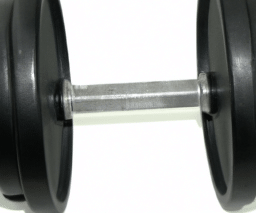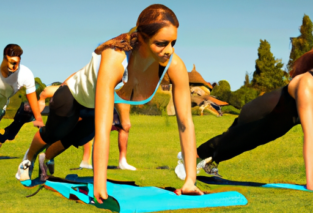So you’ve heard about calisthenics and you’re intrigued. You’ve seen those impressive videos of people performing gravity-defying bodyweight exercises and you want in on the action. But where do you begin? In this article, we’ll show you exactly how to start calisthenics as a beginner. Don’t worry, we’ve got you covered with step-by-step instructions, essential tips, and a supportive community to help you along the way. Get ready to unlock the incredible potential of your own body with the exciting world of calisthenics.
1. Setting Goals
1.1 Determining your fitness level
Before embarking on your calisthenics journey, it’s important to determine your current fitness level. This will help you set realistic goals and tailor your workouts accordingly. Assess your strength, flexibility, and overall endurance to gauge where you stand. You can do a simple fitness test by timing how long it takes you to perform exercises like push-ups, squats, planks, and lunges. This will give you a baseline to track your progress as you continue with your calisthenics routine.
1.2 Establishing short-term and long-term goals
Setting goals is crucial to stay motivated and focused on your calisthenics journey. Start by defining both short-term and long-term goals. Short-term goals can be achieved within a few weeks or months, while long-term goals may take several months or even years. Your short-term goals can include mastering specific exercises, increasing the number of repetitions, or improving your form. Long-term goals can be achieving advanced calisthenics moves, building muscle mass, or increasing overall strength. Write down your goals and keep them somewhere visible to serve as a constant reminder of what you are working towards.
2. Understanding Calisthenics
2.1 Definition of Calisthenics
Calisthenics is a form of exercise that involves using your body weight as resistance to build strength, flexibility, and endurance. Unlike traditional weightlifting, calisthenics doesn’t require any equipment and can be performed anywhere, making it a convenient fitness option for beginners. The word “calisthenics” is derived from the Greek words “kallos” meaning beauty and “sthenos” meaning strength. It focuses on bodyweight movements that engage multiple muscle groups at once, promoting functional strength and a balanced physique.
2.2 Benefits of Calisthenics
Calisthenics offers a multitude of benefits that make it an excellent choice for beginners. Firstly, it improves overall strength and builds lean muscle mass without the need for expensive gym equipment. Secondly, it enhances flexibility, as many calisthenics exercises require a wide range of motion. Thirdly, calisthenics improves cardiovascular fitness and endurance through high-intensity interval training. Lastly, it can be easily modified to suit different fitness levels, making it accessible to people of all ages and abilities.
2.3 Common Calisthenics Exercises
There are numerous common calisthenics exercises that you can incorporate into your workout routine. Some popular ones include:
- Push-ups: A classic exercise that targets the chest, shoulders, triceps, and core.
- Squats: Work the lower body muscles, including the quadriceps, hamstrings, and glutes.
- Planks: Engage the core muscles, helping to develop a strong and stable midsection.
- Pull-ups: Strengthen the back, shoulders, and arms by using a bar to lift your body weight.
- Lunges: Focus on the lower body, particularly the quads, hamstrings, and glutes.
3. Creating a Schedule
3.1 Assessing your time availability
To ensure consistency and progress in your calisthenics journey, it’s important to assess your time availability. Determine how much time you can realistically dedicate to your workouts each week. Consider your work schedule, family commitments, and other personal responsibilities. Set aside specific time slots for your workouts and treat them as important appointments that cannot be compromised. By prioritizing your exercise routine, you increase the likelihood of sticking to it and achieving your fitness goals.
3.2 Designing a workout schedule
Once you have determined your time availability, it’s time to design a workout schedule that suits your needs. Aim to include a combination of strength-building exercises and cardiovascular workouts to achieve a well-rounded fitness routine. Divide your exercise days into different muscle group focuses and incorporate rest days for recovery. For example, you can dedicate one day to upper body exercises, another day to lower body exercises, and one day for full-body workouts. Remember to schedule rest days in between to allow your muscles to recover and grow stronger.
4. Warm-Up and Cool-Down
4.1 Importance of warming up
Before diving into intense calisthenics exercises, warming up is crucial to prepare your body for the workout ahead. Warm-ups gradually increase your heart rate, improve circulation, and loosen up your muscles, reducing the risk of injury. They also activate your nervous system, ensuring optimal performance during your workout. Skipping warm-up exercises can lead to muscle strains, pulls, and other injuries.
4.2 Recommended warm-up exercises
To warm up effectively, include dynamic stretching exercises that engage multiple muscle groups. Start with light cardio exercises such as jogging or cycling for 5-10 minutes to increase your heart rate. Follow this with dynamic stretches like arm circles, leg swings, hip rotations, and trunk twists. Perform each stretch for 10-15 repetitions, focusing on controlled and fluid movements. This will help increase your range of motion and loosen up your joints, preparing your body for the upcoming calisthenics exercises.
4.3 The role of cooling down
Just as warming up is important, cooling down after your workout is equally crucial. Cooling down allows your heart rate to gradually return to its resting state and prevents blood pooling in your extremities. It also helps remove waste products like lactic acid from your muscles, reducing post-workout muscle soreness. Cooling down properly promotes recovery and prepares your body for future workouts.
4.4 Suggested cool-down exercises
To cool down effectively, incorporate static stretching exercises that focus on the major muscle groups you worked during your calisthenics session. Hold each stretch for 15-30 seconds, aiming for a gentle and comfortable stretch without bouncing. Some suggested cool-down stretches include hamstring stretches, calf stretches, shoulder stretches, and quadriceps stretches. Remember to breathe deeply and relax into each stretch, allowing your muscles to gradually relax and recover.
5. Mastering the Basics
5.1 Perfecting bodyweight squats
Bodyweight squats are a fundamental exercise in calisthenics that target the lower body muscles. Start by standing with your feet shoulder-width apart, toes pointing slightly outward. Lower your body down by bending at the hips and knees, pushing your hips back as if sitting into an imaginary chair. Aim to lower down until your thighs are parallel to the ground, keeping your chest lifted and your weight in your heels. Pause for a moment, then push through your heels to return to the starting position. Practice proper form and gradually increase the number of repetitions to build strength and proficiency in bodyweight squats.
5.2 Mastering push-ups
Push-ups are another staple calisthenics exercise that strengthens the chest, shoulders, and triceps. Start in a high plank position with your hands slightly wider than shoulder-width apart and your toes supporting your lower body. Lower your chest towards the ground by bending your elbows while keeping your body in a straight line. Aim to lower until your chest is just above the ground, then push through your hands to return to the starting position. If full push-ups are initially too challenging, modify by performing knee push-ups or using an inclined surface for support. Gradually increase the difficulty by working towards performing full push-ups with proper form.
5.3 Achieving proper pull-up form
Pull-ups are an advanced calisthenics exercise that targets the back, shoulders, and arms. To achieve proper form, start by grasping a pull-up bar with your palms facing away from you, hands slightly wider than shoulder-width apart. Hang with your arms fully extended, engage your core muscles, and squeeze your shoulder blades together. Begin by pulling your body up towards the bar, leading with your chest while keeping your elbows close to your sides. Aim to bring your chin above the bar, then slowly lower yourself back down with control. If you’re unable to perform a full pull-up, start with assisted variations using resistance bands or a chair to support your weight. Gradually decrease the assistance as you build strength and progress towards performing unassisted pull-ups.
5.4 Developing a strong core through planks
Planks are an effective exercise for developing a strong and stable core. Start by positioning yourself face down on the floor with your forearms flat on the ground and your elbows aligned with your shoulders. Engage your core muscles and raise your body off the ground, forming a straight line from your shoulders to your ankles. Avoid sagging or lifting your hips too high. Hold the plank position for as long as you can maintain proper form, gradually increasing the duration as your core strength improves. To modify the exercise, you can perform planks on your knees or elevate your upper body on an inclined surface.
5.5 Practicing lunges for leg strength
Lunges are an excellent calisthenics exercise for strengthening the muscles of your lower body, including the quads, hamstrings, and glutes. Start by standing with your feet hip-width apart. Step forward with one foot, lowering your body until both knees are bent at a 90-degree angle. Make sure your front knee is directly above your ankle and your back knee is hovering just above the ground. Push through your front heel to return to the starting position, then switch legs and repeat the movement. Practice lunges slowly and with control to ensure proper form and balance. As you become more comfortable with lunges, you can increase difficulty by adding dumbbells or performing jumping lunges for a cardiovascular challenge.
6. Progressions and Variations
6.1 Gradual progressions to increase difficulty
As you become more comfortable with the basic calisthenics exercises, it’s important to continually challenge yourself and progress towards more difficult variations. This can be done through gradual progressions that increase the demands on your muscles. For example, if you’ve mastered regular push-ups, you can progress to decline push-ups by elevating your feet on a stable surface. This places more emphasis on your upper chest and shoulders. Similarly, you can progress from regular squats to pistol squats, where you balance on one leg while performing the squat motion. Gradual progressions keep your workouts challenging and prevent plateaus, ensuring continuous improvement.
6.2 Adding variations to exercises
In addition to progressions, incorporating variations into your calisthenics routine adds excitement and targets different muscle groups. For example, you can add diamond push-ups to target your triceps or wide-grip pull-ups to focus on your back muscles. Incorporating movements like mountain climbers, burpees, and Russian twists can engage your core and elevate your heart rate. Experiment with different variations to keep your workouts diverse and engage different muscle groups in new ways. This not only keeps your routine interesting but also helps develop a well-rounded physique.
7. Equipment and Accessories
7.1 Minimal equipment required
One of the great advantages of calisthenics is that it requires minimal equipment. In fact, many calisthenics exercises can be done without any equipment at all. All you truly need is your body weight and a suitable surface to perform the exercises. However, as you progress, you may choose to invest in some basic equipment such as a pull-up bar, resistance bands, or gymnastic rings. These additions can greatly increase the range of exercises you can perform, allowing for a more comprehensive calisthenics routine.
7.2 Recommended calisthenics accessories
While minimal equipment is required for calisthenics, there are a few accessories that can enhance your workouts and aid in your progress. Firstly, a pull-up bar is a valuable investment as it provides a stable surface for performing pull-ups, chin-ups, and other hanging exercises. Resistance bands are versatile tools that can be used to assist or resist various movements, allowing for progressive overload. Gymnastic rings are another valuable accessory that can be hung from a sturdy bar or tree branch. They offer increased instability, engaging more stabilizer muscles and providing a challenge for advanced exercises like ring dips and muscle-ups. Additionally, investing in a yoga mat and foam roller can provide comfort and aid in post-workout recovery.
8. Nutrition and Hydration
8.1 Fueling your body properly
Proper nutrition plays a vital role in supporting your calisthenics journey. Fueling your body with balanced and nutrient-dense meals will provide the energy necessary for optimal performance and muscle recovery. Include a variety of lean protein sources, whole grains, fruits, vegetables, and healthy fats in your diet. Prioritize foods rich in vitamins, minerals, and antioxidants to support overall health and well-being. Be mindful of your calorie intake, ensuring you consume enough to support your goals, whether it’s weight loss, muscle gain, or maintenance.
8.2 Hydration for optimal performance
Staying hydrated is equally important in calisthenics as it is in any form of exercise. Dehydration can lead to muscle cramps, reduced performance, and impaired recovery. Make sure to drink water before, during, and after your workouts to maintain optimal hydration levels. The amount of water you need will depend on various factors such as your body size, exercise intensity, and environmental conditions. Aim to drink at least 8 cups (64 ounces) of water per day as a general guideline.
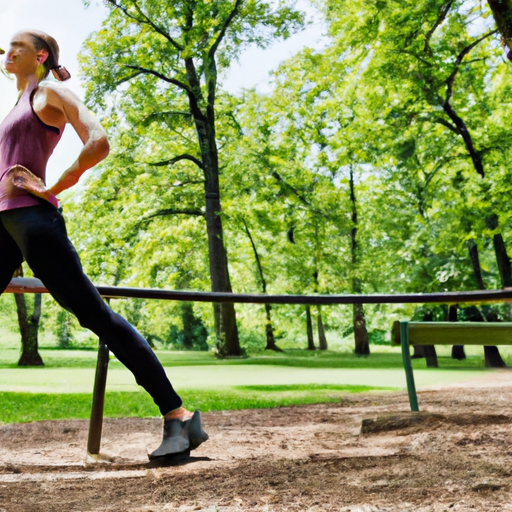
9. Overcoming Challenges
9.1 Staying motivated
Staying motivated throughout your calisthenics journey is crucial to ensure long-term success. Set goals that are meaningful to you and periodically reassess and adjust them as needed. Find a workout buddy or join a fitness community to stay motivated and accountable. Mix up your routines, incorporate new exercises or challenges, and track your progress to keep things interesting. Celebrate your achievements, both big and small, to stay positive and motivated on your fitness journey.
9.2 Dealing with plateaus and setbacks
Plateaus and setbacks are a natural part of any fitness journey, but they shouldn’t discourage you from continuing. When you reach a plateau, where progress seems to stall, it’s a sign that your body has adapted to your current routine. To overcome plateaus, try incorporating new exercises, increasing the intensity or volume of your workouts, or experimenting with different variations. Setbacks, such as injuries or life events that interrupt your routine, can be frustrating. Instead of getting discouraged, focus on the recovery process and find alternative ways to stay active and maintain your progress. Remember that setbacks are temporary, and with perseverance, you will regain momentum.
9.3 Avoiding injury
Injury prevention is a key aspect of any exercise program, including calisthenics. To minimize the risk of injury, ensure proper form and technique in all exercises. Progress gradually and listen to your body, avoiding overtraining or pushing through pain. Incorporate rest days and recovery practices like stretching and foam rolling to give your muscles time to repair and rebuild. If you experience persistent pain or discomfort, consult a healthcare professional for proper evaluation and guidance.
10. Tracking Progress
10.1 Importance of tracking progress
Tracking your progress is essential for staying motivated and evaluating the effectiveness of your calisthenics routine. Keep a record of your workouts, including the exercises performed, sets, reps, and any modifications or progressions. Take measurements of your body, such as weight, body fat percentage, and circumference measurements, to monitor physical changes. Additionally, consider tracking other aspects of your fitness journey, such as endurance levels, flexibility, and strength milestones. Regularly reviewing your progress will help you identify areas of improvement and celebrate achievements along the way.
10.2 Utilizing fitness apps and journals
There are plenty of fitness apps and journals available that can help you track your progress and streamline your calisthenics journey. These tools often provide features like workout logs, exercise libraries, progress charts, and reminders. They can serve as a valuable resource to plan and organize your workouts, record your progress, and set reminders for upcoming training sessions. Find an app or journal that fits your preferences and integrates well with your lifestyle to maximize the benefits of tracking your calisthenics progress.
